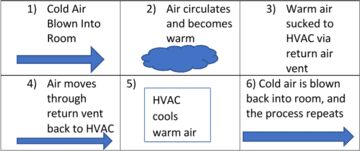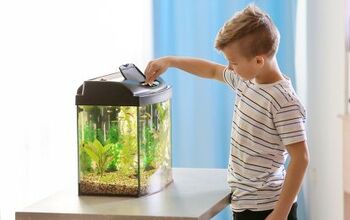Can You Block A Return Air Vent?

Return air vents keep your home’s air fresh and circulated. If you’re remodeling a room, or even just rearranging some furniture, you may wonder: can I block that vent? It doesn’t seem to be doing anything. Those return vents are a vital component of your home’s air circulatory system.
You should never block a return air vent as this can cause problems in air circulation, humidity, and toxic mold. As part of the HVAC system, return air vents help properly circulate air around your home, and by blocking an air vent you can damage your HVAC system which can be very dangerous.
Reasons to Keep a Return Air Vent Clear
While those grilles may look ugly, they serve a purpose. As tempting as it might be to cover them up, here are few reasons to keep them clear:
- You’re HVAC System will function more efficiently
- You will have less air stagnation
- Fewer HVAC Repairs
If you’re having trouble understanding why your return air vents are so important, here’s something to think about – breathing. When you breathe, you are performing something called ventilation. Proper ventilation is also what your return air vents are there to achieve.
Now imagine you’re having a hard time breathing. Or imagine the feeling you get when you have a cold and can only breathe through one side of your nose. You’re stuffy. You’re clogged. Your system isn’t running efficiently. A clogged nose is similar to what happens when you cover a return air vent.
Think of your HVAC system as the lungs of your home. When the return air vents are covered, your house can’t properly breathe.
How Your Return Air Vent Works
Your return air vent is another component of your HVAC’s air circulatory system.
Here is a simple diagram to show you how it works:
If you follow this table, you can see that your HVAC works in a cyclical pattern. If this pattern breaks, your HVAC won’t work effectively.
Look at steps three and four of the diagram. These steps are when warm air gets sucked back to the HVAC to be cooled. When you cover your return air vent, you are removing these steps. The system can’t remove the warm air, and your AC isn’t able to cool the room properly.
Not only will blocking a return air vent prevent you from having a comfortable room, but it can also cause several serious issues.
Dangers of Blocking a Return Air Vent
Harm to your HVAC system is probably the biggest concern. However, there are a few other health concerns to consider.
- If return vents are blocked, your HVAC system may try to pull air from other places. These places might not be clean.
- Air stagnation can cause humidity to build up. A humid environment promotes mold and rot.
If your HVAC is not able to pull air back through the return air vent, then it will try to pull it from somewhere is. This could mean that it tries to pull air from outside. Depending on where you live, this air may not be clean and could cause problems in your system.
Pressure Build-UpYour HVAC system has a pressure gradient it is trying to maintain. If your return vents are blocked, pressure can build up in the room. Increased pressure will cause your HVAC supply vents, the vents that are blowing the air into the room, to work harder and become less efficient.
Air StagnationThe other issue we mentioned was air stagnation leading to increased humidity. Perhaps you’ve heard the phrase, moving water is clean water. Well, the same is generally true for air. When your return air vent is blocked, there is less air movement. This stagnation allows moisture and dust to build up. These things can lead to mold and rot – two very unpleasant things.
What to Do if Your Return Air Duct is Blocked
Thankfully, there are some things you can do to remedy a blocked return air vent. Here are some ideas to help you get your room healthy again.
- Make sure there are no pieces of furniture or large objects covering the return vent
- Check to see if your return vents need a good cleaning
- Consider replacing vent grille with a more efficient design
Make Sure the Return Vent is Clear of Objects
This is the most obvious one, but also the most important. If you have a newer house, you likely have a return air vent in every room. In a step-by-step fashion, go through every room in your home and make sure no objects are crowding the vent.
Not sure which grille is the return air vent? Turn on your AC system. The vent that is blowing the cold air is called the supply vent. The vent that doesn’t seem to be doing anything is your return vent.
You should be able to place a piece of paper over the vent and have it stick to the grille due to negative pressure – just be sure not to clog the vent!
Clean Return Vent
Due to the slight negative pressure created in the return vent, small debris tends to get sucked in with the air. Make a scheduled cleaning time for your return vents and clean them with a dust cloth. Look to see if the vent needs to be removed and cleaned with soap and water.
This is also a great time to put a new filter on your return air vent. Click here to read our article on return air vent filters.
Replace Vent Cover
The older return vent covers can be restrictive. They now build newer vent covers that allow for better airflow. This is a simple thing to do, and it will help your HVAC system better perform its job.
If you’ve done all these things listed, but still feel your HVAC isn’t working correctly, then you might not have enough return vents. Homes built before the 1960s, or homes that didn’t initially have a full HVAC system, might not have return vents in every room. If this is the case, the next chance you get, you should have return vents installed in every room.
See our article on how many return vents you need in your home.
Wrapping Up
Your return air vents are essential. If you remember to keep them clear and clean, then you shouldn’t have any major issues. However, if you feel your home isn’t getting the proper amount of air circulation, you may need to install more return air vents.
Being aware of return air vents and knowing they need to remain clear of furniture and dust will keep your HVAC system running smoothly.
Take a moment to look around your home and ask: Is there anything else I’m wondering about? Do I know what that nob does? What’s that box on the side of my house?
These are good questions. Don’t overlook them.
Related Guide

We are a team of passionate homeowners, home improvement pros, and DIY enthusiasts who enjoy sharing home improvement, housekeeping, decorating, and more with other homeowners! Whether you're looking for a step-by-step guide on fixing an appliance or the cost of installing a fence, we've here to help.
More by Upgraded Home Team













![10 Best Zero Turn Mowers – [2022 Reviews & Ultimate Buyer's Guide]](https://cdn-fastly.upgradedhome.com/media/2023/07/31/9070522/10-best-zero-turn-mowers-2022-reviews-ultimate-buyer-s-guide.jpg?size=350x220)














